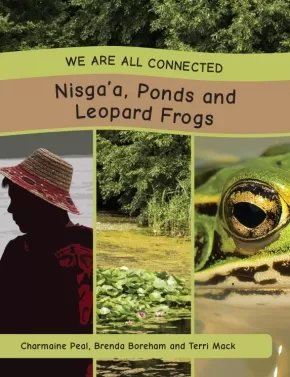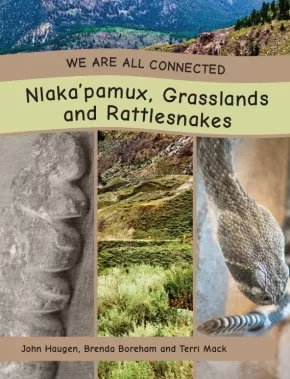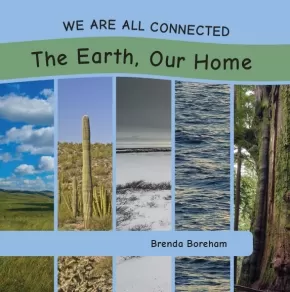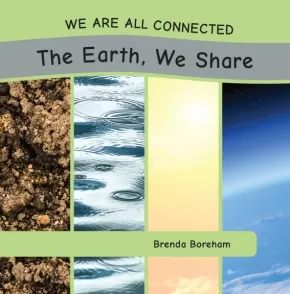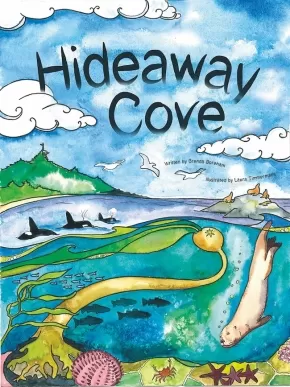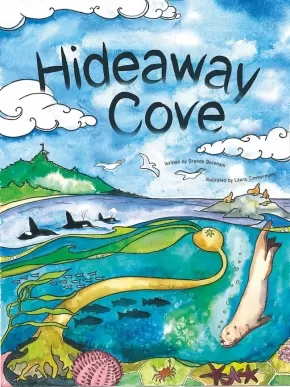
Series
106
-
120
of
268 Results;
Sort By
Go To
of 18
We Are All Connected: Métis, Wetlands and Mallards
 $21.95
$21.95

Format:
Paperback
Text Content Territories:
Indigenous Canadian; Métis;
ISBN / Barcode: 9781771742511
Synopsis:
Synopsis:
“We Are All Connected” is a series that explores how we all live together in a shared balance upon Mother Earth. Each book explores a specific ecosystem with a focus on one animal and its adaptations for survival within that ecosystem. Indigenous interviewees, each living within the same area, have responded to strategic questions as to how their community interacts with the land, their traditional territory. Explore each text with a sense of inquiry in mind.
8 We Are All Connected Titles Coast Salish, Coastal Rainforests and Cougars Haisla, Rivers and Chinook Salmon Inuit, Tundra and Ravens Lakota, Mixed Grasslands and Bald Eagles Métis, Wetlands and Mallards Nisga'a, Ponds and Leopard Frogs Nlaka'pamux, Grasslands and Rattlesnakes Sto:lo, Riparian Forests and Black Bears Each title covers the following curricular areas. Traditional storytelling and artwork begin each title from the focus Indigenous territory. Science: Biodiversity, classification, life cycles, food chains, food webs and connections between living and non-living things are just some of the science concepts included in each book. Social Studies: Contemporary and historical Indigenous cultural knowledge flows throughout each book. Local land forms, gatherings, harvesting practices and government are some of the social studies concepts included in each book.
2 Foundation Titles The two foundational books provide deeper understanding of the content of the “We Are All Connected” titles. We Are All Connected: The Earth, Our Home- explores biomes, ecosystems and biodiversity. We Are All Connected: The Earth, We Share- explores the interconnectedness between living and non-living things.
Authenticity Note: This book contains some Indigenous artwork and photos throughout, such as artwork from Leah Marie Dorion.
Additional Information
32 pages | 8.50" x 11.00" | ISBN: 9781771742511
We Are All Connected: Nisga'a, Ponds and Leopard Frogs
 $21.95
$21.95

Format:
Paperback
Text Content Territories:
Indigenous Canadian; First Nations; Nisga'a;
ISBN / Barcode: 9781771742498
Synopsis:
Synopsis:
“We Are All Connected” is a series that explores how we all live together in a shared balance upon Mother Earth. Each book explores a specific ecosystem with a focus on one animal and its adaptations for survival within that ecosystem. Indigenous interviewees, each living within the same area, have responded to strategic questions as to how their community interacts with the land, their traditional territory. Explore each text with a sense of inquiry in mind.
8 We Are All Connected Titles Coast Salish, Coastal Rainforests and Cougars Haisla, Rivers and Chinook Salmon Inuit, Tundra and Ravens Lakota, Mixed Grasslands and Bald Eagles Métis, Wetlands and Mallards Nisga'a, Ponds and Leopard Frogs Nlaka'pamux, Grasslands and Rattlesnakes Sto:lo, Riparian Forests and Black Bears Each title covers the following curricular areas. Traditional storytelling and artwork begin each title from the focus Indigenous territory. Science: Biodiversity, classification, life cycles, food chains, food webs and connections between living and non-living things are just some of the science concepts included in each book. Social Studies: Contemporary and historical Indigenous cultural knowledge flows throughout each book. Local land forms, gatherings, harvesting practices and government are some of the social studies concepts included in each book.
2 Foundation Titles The two foundational books provide deeper understanding of the content of the “We Are All Connected” titles. We Are All Connected: The Earth, Our Home- explores biomes, ecosystems and biodiversity. We Are All Connected: The Earth, We Share- explores the interconnectedness between living and non-living things.
Authenticity Note: This work contains some Indigenous artwork and photographs throughout, such as artwork and photos from Charmaine Peal.
Additional Information
32 pages | 8.50" x 11.00" | ISBN: 9781771742498
We Are All Connected: Nlaka'pamux, Dry Grasslands and Rattlesnakes
 $21.95
$21.95

Format:
Paperback
Text Content Territories:
Indigenous Canadian; First Nations; Salish; Interior Salish; Nlaka'pamux (Thompson);
ISBN / Barcode: 9781771742528
Synopsis:
Synopsis:
“We Are All Connected” is a series that explores how we all live together in a shared balance upon Mother Earth. Each book explores a specific ecosystem with a focus on one animal and its adaptations for survival within that ecosystem. Indigenous interviewees, each living within the same area, have responded to strategic questions as to how their community interacts with the land, their traditional territory. Explore each text with a sense of inquiry in mind.
8 We Are All Connected Titles Coast Salish, Coastal Rainforests and Cougars Haisla, Rivers and Chinook Salmon Inuit, Tundra and Ravens Lakota, Mixed Grasslands and Bald Eagles Métis, Wetlands and Mallards Nisga'a, Ponds and Leopard Frogs Nlaka'pamux, Grasslands and Rattlesnakes Sto:lo, Riparian Forests and Black Bears Each title covers the following curricular areas. Traditional storytelling and artwork begin each title from the focus Indigenous territory. Science: Biodiversity, classification, life cycles, food chains, food webs and connections between living and non-living things are just some of the science concepts included in each book. Social Studies: Contemporary and historical Indigenous cultural knowledge flows throughout each book. Local land forms, gatherings, harvesting practices and government are some of the social studies concepts included in each book.
2 Foundation Titles The two foundational books provide deeper understanding of the content of the “We Are All Connected” titles. We Are All Connected: The Earth, Our Home- explores biomes, ecosystems and biodiversity. We Are All Connected: The Earth, We Share- explores the interconnectedness between living and non-living things.
Authenticity Note: This title includes some authentic Indigenous photographs.
Additional Information
32 pages | 8.50" x 11.00" | ISBN: 9781771742528
We Are All Connected: Sto:lo, Riparian Forests and Black Bears
 $21.95
$21.95

Format:
Paperback
Text Content Territories:
Indigenous Canadian; First Nations; Salish; Coast Salish; Sto:lo;
ISBN / Barcode: 9781771742450
Synopsis:
Synopsis:
“We Are All Connected” is a series that explores how we all live together in a shared balance upon Mother Earth. Each book explores a specific ecosystem with a focus on one animal and its adaptations for survival within that ecosystem. Indigenous interviewees, each living within the same area, have responded to strategic questions as to how their community interacts with the land, their traditional territory. Explore each text with a sense of inquiry in mind.
8 We Are All Connected Titles Coast Salish, Coastal Rainforests and Cougars Haisla, Rivers and Chinook Salmon Inuit, Tundra and Ravens Lakota, Mixed Grasslands and Bald Eagles Métis, Wetlands and Mallards Nisga'a, Ponds and Leopard Frogs Nlaka'pamux, Grasslands and Rattlesnakes Sto:lo, Riparian Forests and Black Bears Each title covers the following curricular areas. Traditional storytelling and artwork begin each title from the focus Indigenous territory. Science: Biodiversity, classification, life cycles, food chains, food webs and connections between living and non-living things are just some of the science concepts included in each book. Social Studies: Contemporary and historical Indigenous cultural knowledge flows throughout each book. Local land forms, gatherings, harvesting practices and government are some of the social studies concepts included in each book.
2 Foundation Titles The two foundational books provide deeper understanding of the content of the “We Are All Connected” titles. We Are All Connected: The Earth, Our Home- explores biomes, ecosystems and biodiversity. We Are All Connected: The Earth, We Share- explores the interconnectedness between living and non-living things.
Authenticity Note: This book contains some Indigenous artwork and photographs, such as photos from Rod Peters and artwork from Celestine Aleck.
Additional Information
32 pages | 8.50" x 11.00" | ISBN: 9781771742450
We Are All Connected: The Earth, Our Home
 $11.95
$11.95

Format:
Paperback
ISBN / Barcode: 9781771742535
Synopsis:
Synopsis:
“We Are All Connected” is a series that explores how we all live together in a shared balance upon Mother Earth. Each book explores a specific ecosystem with a focus on one animal and its adaptations for survival within that ecosystem. Indigenous interviewees, each living within the same area, have responded to strategic questions as to how their community interacts with the land, their traditional territory. Explore each text with a sense of inquiry in mind.
8 We Are All Connected Titles Coast Salish, Coastal Rainforests and Cougars Haisla, Rivers and Chinook Salmon Inuit, Tundra and Ravens Lakota, Mixed Grasslands and Bald Eagles Métis, Wetlands and Mallards Nisga'a, Ponds and Leopard Frogs Nlaka'pamux, Grasslands and Rattlesnakes Sto:lo, Riparian Forests and Black Bears Each title covers the following curricular areas. Traditional storytelling and artwork begin each title from the focus Indigenous territory. Science: Biodiversity, classification, life cycles, food chains, food webs and connections between living and non-living things are just some of the science concepts included in each book. Social Studies: Contemporary and historical Indigenous cultural knowledge flows throughout each book. Local land forms, gatherings, harvesting practices and government are some of the social studies concepts included in each book.
2 Foundation Titles The two foundational books provide deeper understanding of the content of the “We Are All Connected” titles. We Are All Connected: The Earth, Our Home- explores biomes, ecosystems and biodiversity. We Are All Connected: The Earth, We Share- explores the interconnectedness between living and non-living things.
Additional Information
32 pages | 8.00" x 8.00" | ISBN: 9781771742535
We Are All Connected: The Earth, We Share
 $11.95
$11.95

Format:
Paperback
ISBN / Barcode: 9781771742542
Synopsis:
Synopsis:
“We Are All Connected” is a series that explores how we all live together in a shared balance upon Mother Earth. Each book explores a specific ecosystem with a focus on one animal and its adaptations for survival within that ecosystem. Indigenous interviewees, each living within the same area, have responded to strategic questions as to how their community interacts with the land, their traditional territory. Explore each text with a sense of inquiry in mind.
8 We Are All Connected Titles Coast Salish, Coastal Rainforests and Cougars Haisla, Rivers and Chinook Salmon Inuit, Tundra and Ravens Lakota, Mixed Grasslands and Bald Eagles Métis, Wetlands and Mallards Nisga'a, Ponds and Leopard Frogs Nlaka'pamux, Grasslands and Rattlesnakes Sto:lo, Riparian Forests and Black Bears Each title covers the following curricular areas. Traditional storytelling and artwork begin each title from the focus Indigenous territory. Science: Biodiversity, classification, life cycles, food chains, food webs and connections between living and non-living things are just some of the science concepts included in each book. Social Studies: Contemporary and historical Indigenous cultural knowledge flows throughout each book. Local land forms, gatherings, harvesting practices and government are some of the social studies concepts included in each book.
2 Foundation Titles The two foundational books provide deeper understanding of the content of the “We Are All Connected” titles. We Are All Connected: The Earth, Our Home- explores biomes, ecosystems and biodiversity. We Are All Connected: The Earth, We Share- explores the interconnectedness between living and non-living things.
Additional Information
32 pages | 8.00" x 8.00" | ISBN: 9781771742542
FLASH SALE! Raven Series: Raven Sings the ABC's (Big Book)
 $14.97 $19.95
$14.97 $19.95

Artists:
Format:
Coil Bound
Text Content Territories:
Indigenous Canadian; First Nations; Kwakwaka'wakw (Kwakiutl);
ISBN / Barcode: 9781771741514
Synopsis:
Synopsis:
Follow Raven as he introduces each letter of the alphabet! Have fun naming each of the images for each letter.
Educator & Series Information
This book is part of the Raven Series, a set of six books written for the emergent reader and learner. Each book focuses on a specific learning intention that builds on strengthening learning with the support of an adult.
A Little Note about the Alphabet:
Learning the alphabet is a foundational skill and learning through song is a wonderful way to learn! In hopes to eliminate confusion of learning to identify letters, we have typeset the letters in a specific manner. For example, L M N O P is not one letter and for young learners can be mistaken as such if not broken up. As you are singing the song slowly together, pointing at each letter will support young learners significantly. Notice that we pluralize alphabet to indicate there are many kinds.
Each letter of the alphabet in the book has a corresponding picture. Taking the time to talk about each picture, over several reads, will support building vocabulary. Some of the pictures are from other Raven books to help learners make connections from book to book.
This book is available in French: Corbeau chante la chanson de l’alphabet
Note: French version dimensions differ.
Additional Information
16 pages | Dimensions: 10" x 14" | ISBN: 9781771741514
Hideaway Cove (HC)
 $21.95
$21.95

Artists:
Format:
Hardcover
ISBN / Barcode: 9781771741347
Synopsis:
Synopsis:
Join us on a mid August day, on the wild and rocky shores of the Pacific Northwest Coast. From the orca to the tiniest barnacle, enjoy a colourful glimpse into the lives of the many creatures that live in, and around, Hideaway Cove.
Brenda Boreham and Laura Timmermans share with us, through words and illustrations, the many interconnections within a healthy marine eco-system.
Reviews
"Hideaway Cove is a must-have when teaching a seashore ecosystem unit. This book provides opportunities for students to share their connections with the seashore while they learn more about the interactions within the marine ecosystem.” – Cindy Haack, Canadian Teacher Magazine
“Hideaway Cove is a delightful, information-packed picture book that takes children through a day in the life of a west coast cove. Here, humans are noticeably absent, and the diverse plants and animals tell a wonderful tale. Brenda Boreham’s text is lyrical and rich in detail.” – Sheryl McFarlane, Hakai Magazine
Educator & Series Information
Each book in the By Day and By Night Nature Series focuses on a scene typical of a distinct west coast habitat, showing how living and non-living things are connected in a healthy ecosystem. As readers, we observe animals going about their daily activities: caring for their young, searching for food, and responding to the changes in light, temperature, and weather conditions throughout the day or night. The last four pages of each book provide facts about the highlighted animals and plants as well as features that are unique to their habitats. The final page suggests ways that young readers and their families can be respectful as they visit wilderness areas.
Readers with a sense of curiosity will find opportunities in these books to:
- use picture clues to predict the featured animal on the next page
- identify, count, and sequence numbers (1 owl, 2 deer, 3 squirrels, etc.)
- search for small creatures that travel from page to page
- discover patterns in the text and structure of the books
- track the movement of the sun, or moon, across the sky
Curriculum Links
Reading - Providing opportunities for guided practise in using reading strategies: visualizing, making connections, asking questions, transforming, and inferring.
Science - Supporting discussion and further exploration:
- characteristics of living things
- needs of living things
- connections between living and non-living things
- daily and seasonal changes
- animal growth and changes
- plant growth and changes
- weather
- habitats
- observable patterns in the sky
Numeracy - Counting and sequencing of numbers 1 to 10.
Social Responsibility - Initiating discussions about ways to take care of wilderness areas.
Search for a crab that travels from page to page in this story!
Additional Information
32 Pages | ISBN" 9781771741347 | Hardcover
Hideaway Cove (PB)
 $14.50
$14.50

Artists:
Format:
Paperback
ISBN / Barcode: 9781771741330
Synopsis:
Synopsis:
Join us on a mid August day, on the wild and rocky shores of the Pacific Northwest Coast. From the orca to the tiniest barnacle, enjoy a colourful glimpse into the lives of the many creatures that live in, and around, Hideaway Cove.
Brenda Boreham and Laura Timmermans share with us, through words and illustrations, the many interconnections within a healthy marine eco-system.
Reviews
"Hideaway Cove is a must-have when teaching a seashore ecosystem unit. This book provides opportunities for students to share their connections with the seashore while they learn more about the interactions within the marine ecosystem.” – Cindy Haack, Canadian Teacher Magazine
“Hideaway Cove is a delightful, information-packed picture book that takes children through a day in the life of a west coast cove. Here, humans are noticeably absent, and the diverse plants and animals tell a wonderful tale. Brenda Boreham’s text is lyrical and rich in detail.” – Sheryl McFarlane, Hakai Magazine
Educator & Series Information
Each book in the By Day and By Night Nature Series focuses on a scene typical of a distinct west coast habitat, showing how living and non-living things are connected in a healthy ecosystem. As readers, we observe animals going about their daily activities: caring for their young, searching for food, and responding to the changes in light, temperature, and weather conditions throughout the day or night. The last four pages of each book provide facts about the highlighted animals and plants as well as features that are unique to their habitats. The final page suggests ways that young readers and their families can be respectful as they visit wilderness areas.
Readers with a sense of curiosity will find opportunities in these books to:
- use picture clues to predict the featured animal on the next page
- identify, count, and sequence numbers (1 owl, 2 deer, 3 squirrels, etc.)
- search for small creatures that travel from page to page
- discover patterns in the text and structure of the books
- track the movement of the sun, or moon, across the sky
Curriculum Links
Reading - Providing opportunities for guided practise in using reading strategies: visualizing, making connections, asking questions, transforming, and inferring.
Science - Supporting discussion and further exploration:
- characteristics of living things
- needs of living things
- connections between living and non-living things
- daily and seasonal changes
- animal growth and changes
- plant growth and changes
- weather
- habitats
- observable patterns in the sky
Numeracy - Counting and sequencing of numbers 1 to 10.
Social Responsibility - Initiating discussions about ways to take care of wilderness areas.
Search for a crab that travels from page to page in this story!
Additional Information
32 Pages | ISBN: 9781771741330 | Paperback
Raven Series Bundle
 $107.73 $114.72
$107.73 $114.72

Text Content Territories:
Indigenous Canadian; First Nations; Kwakwaka'wakw (Kwakiutl);
ISBN / Barcode: 9781771745888
Synopsis:
Synopsis:
The Raven Series is a set of six books written for the emergent reader and learner. Each book focuses on a specific learning intention that builds on strengthening learning with the support of an adult.
The titles and their learning intentions are:
- Raven and the Box: promotes an oral retell
- Raven and Duck: basic concepts
- Raven and Frog Count: number recognition
- I Spy Raven: rhyme and perspective
- Raven Sings the ABC's: letter recognition, vocabulary building
- Raven Makes a Necklace: colours and patterns
Educator Information
This resource is also available in French HERE!
Additional Information
ISBN: 9781771745888
Raven Series: I Spy Raven (Big Book)
 $19.95
$19.95

Artists:
Format:
Coil Bound
Text Content Territories:
Indigenous Canadian; First Nations; Kwakwaka'wakw (Kwakiutl);
ISBN / Barcode: 9781771741545
Synopsis:
Synopsis:
Watch as six little insects keep an eye on Raven as he settles in to go to sleep. The sky darkens and the stars come out only to reveal something very big at the end.
Educator & Series Information
This book is part of the Raven Series, a set of six books written for the emergent reader and learner. Each book focuses on a specific learning intention that builds on strengthening learning with the support of an adult.
A Little Note about Rhyming and Perspective:
Learning rhyme is a foundational skill and this book provides opportunity to explore rhythm, rhyme and visual perspective. A learner’s ability to recognize words that rhyme will support them as they begin to learn word families later on. A simple word family is the “at” family: bat, cat, hat, mat etc. When a learner can recognize the rhyming sounds, or words, they can begin to anticipate the text. As well, a learner’s ability to understand visual perspective allows them to understand the storyline deeper. The visual perspective changes under a magnifying glass.
This resource is available in French: Je vois Corbeau
Note: French book dimensions differ.
Additional Information
16 pages | Dimensions: 10" x 14" | ISBN: 9781771741545
Raven Series: Raven and Duck (Big Book)
 $19.95
$19.95

Artists:
Format:
Coil Bound
Text Content Territories:
Indigenous Canadian; First Nations; Kwakwaka'wakw (Kwakiutl);
ISBN / Barcode: 9781771741569
Synopsis:
Synopsis:
Raven and Duck are good friends. They like to play together outside in the summer sun but most of what they do is opposite to the other.
Educator & Series Information
This book is part of the Raven Series, a set of six books written for the emergent reader and learner. Each book focuses on a specific learning intention that builds on strengthening learning with the support of an adult.
A Little Note about Opposites:
Learning opposites is a foundational skill. So many functions of our daily lives are around sorting and categorizing and understanding opposites is a great beginning. As well, knowing what opposites are supports a young learner in both comprehension and vocabulary. Understanding a storyline that describes something big and something small will support comprehension. With the addition of opposite words in a young learner’s vocabulary, they can now add a description to things. As an example, the beginning stages of use may be the big boat and the small boat. As language progresses it may turn to the large boat and the little boat. At an even deeper progression, it may turn to the humongous boat and the tiny boat.
This resource is available in French: Corbeau et Canard
Note: Book dimensions differ in French.
Additional Information
16 pages | Dimensions: 10" x 14" | ISBN: 9781771741569
Raven Series: Raven and Frog Count (Big Book)
 $19.95
$19.95

Artists:
Format:
Coil Bound
Text Content Territories:
Indigenous Canadian; First Nations; Kwakwaka'wakw (Kwakiutl);
ISBN / Barcode: 9781771741538
Synopsis:
Synopsis:
Join Raven and Frog as they both count to ten in their own way. Raven teaches one to ten in rhyme and with a focus on number recognition. Frog teaches one to ten with visual supports of number representation.
Educator & Series Information
This book is part of the Raven Series, a set of six books written for the emergent reader and learner. Each book focuses on a specific learning intention that builds on strengthening learning with the support of an adult.
A Little Note about Counting:
Learning to count is a foundational skill and our world is full of numbers. Young learners will learn early on in life that they can have one candy, not ten. In order to support the learning we can teach first what the numbers 1 to 10 look like while counting/naming them. After many practises counting/naming, we can then teach the amount of each number. For example, we can show the learners; I can hold one cracker in my left hand and two crackers in my right hand. Last, we can show number representation in a pattern, like the number patterns on dice. Of course, this is only the beginning of discovering that our world is full of math but this is such a great start for any young learner.
This resource is available in French: Corbeau et Grenouille comptent
Note: French book dimensions differ.
Additional Information
16 pages | Dimensions: 10" x 14" | ISBN: 9781771741538
Raven Series: Raven and the Box (Big Book)
 $19.95
$19.95

Artists:
Format:
Coil Bound
Text Content Territories:
Indigenous Canadian; First Nations; Kwakwaka'wakw (Kwakiutl);
ISBN / Barcode: 9781771741521
Synopsis:
Synopsis:
Based on a traditional story, Raven and the Box is a simple storyline. With each action that Raven makes you can play along with your own actions.
Educator & Series Information
This book is part of the Raven Series, a set of six books written for the emergent reader and learner. Each book focuses on a specific learning intention that builds on strengthening learning with the support of an adult.
A Little Note about Retelling:
Learning to tell and retell stories is a foundational skill. Oral retells promote comprehension and build vocabulary capacity. This story allows actions to be performed as it is being told. Actions can sometimes support the retelling of a storyline. Invite learners and their families to come in and share one of their own traditional family stories.
This resource is available in French: Corbeau et la boîte
Note: French book dimensions differ.
Additional Information
16 pages | Dimensions: 10" x 14" | ISBN: 9781771741521
Raven Series: Raven Makes a Necklace (Big Book)
 $19.95
$19.95

Artists:
Format:
Coil Bound
Text Content Territories:
Indigenous Canadian; First Nations; Kwakwaka'wakw (Kwakiutl);
ISBN / Barcode: 9781771741552
Synopsis:
Synopsis:
Follow Raven as he flies around looking for coloured beads to make a necklace. The beads he finds are different shapes and colours.
Educator & Series Information
This book is part of the Raven Series, a set of six books written for the emergent reader and learner. Each book focuses on a specific learning intention that builds on strengthening learning with the support of an adult.
A Little Note about Shapes and Colours:
Sorting by shapes and colours is a foundational skill. Our world is full of shapes and colours! Young learners strive to make sense of their surroundings and look to identify shapes and colours either in real life or through multimedia. Once learned a young learner can then sort and categorize many things by shape or colour.
This resource is available in French: Corbeau fait un collier
Note: French book dimensions differ.
Additional Information
16 pages | Dimensions: 10" x 14" | ISBN: 9781771741552
Sort By
Go To
of 18




